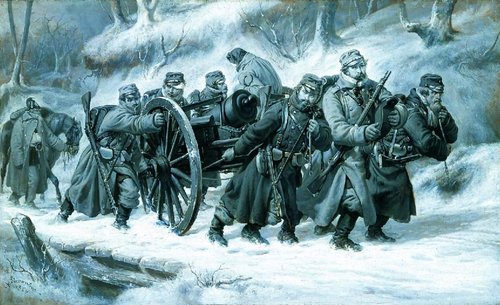The meaning of the Second Schleswig War ('1864') in Denmark
Denmark lost a third of its territory and 40% of its population in the Second Schleswig War in 1864 to Prussia and Austria. Seen as both a national trauma and the creation of modern-day Denmark, narratives regarding the war that were created at the time - and since - continue to resonate, exemplified by recent debates over its portrayal in TV programmes and artwork.

Denmark’s defeat to Prussia and Austria in the Second Schleswig War in 1864 meant that the Danish state lost the two German duchies of Holstein and Lauenburg, and the ethnically mixed Danish duchy of Schleswig; a loss of a third of its territory and 40% of the state’s population. All political parties in Denmark at the time washed their hands of the situation and blamed their political opponents or foreign powers for the defeat. At the same time, they created political narratives that continue to affect Danish politics, historiography, art, and national identity.
The status of the war within Danish history is reflected by the fact that it is normally referred to simply as “1864”, the year the war was fought. The defeat marked the end of the Danish-German composite state, the formation of the Danish nation-state, and the creation of modern-day Denmark. It is seen as a national trauma that gave birth to an existential angst, and it has been claimed that the defeat is central to any grasp of Danish identity, culture, history, and politics.
1864 is still relevant
Politics, history, and art are interconnected with respect to the war. Politicians, historians and artists have understood and used the past in different ways, often to further their present-day agendas, for example, with respect to the Balkans war in the 1990s and Afghanistan in 2000s. Even today the Second Schleswig War can spark controversy. For example, the Danish TV-series ‘1864’ in 2014 resulted in a heated public debate between the director, artist, politicians, historians and ordinary Danes.
Similarly, a cartoon printed in 2013 in connection with the withdrawal of Danish troops from Afghanistan paraphrased an earlier iconic painting by Niels Simonsen of the retreat from Danevirke in 1864, replacing the canon with a tank and the soldiers with present-day politicians. The underlying idea being that history – and Danish foreign policy – repeats itself, the first time as a tragedy, the second time as a farce. Other works of art also use 1864 in a meaningful way, such as Thomas Kluge’s painting from 2014 which reflects the artist’s perception that Danish national identity is marked by an inferiority complex and an ambiguous relationship to Germany and the European Union, which according to the painter can be traced back to ‘1864’. These and other discussions demonstrate that historical perspectives on the connection between politics and identity, the interplay between politics, history and art, and how the past and the present affects each other is important and that the war of 1864 still resonates today.

Thomas Kluge's '1864'. Photo: Courtesy of Museum Sønderjylland Sønderborg Slot.
Further reading:
- Adriansen & S. B. Frandsen, eds, Efter 1864. Krigens følger på kort og langt sigt. [The consequences of war in the short and long term] (Syddansk Universitetsforlag: Odense, 2016).
- R. Glenthøj, 1864. Sønner af de slagne. [Sons of the defeated] (Gads Forlag: København, 2014).
- R. Glenthøj, ’1864 før, nu og i fremtiden. Fortællinger i nyere og ældre dansk 1864-historiografi’, [1864 before, now and in the future. Accounts in contemporary and older Danish 1864 historiography]. Historisk Tidsskrift, Bind 117, Hæfte 2, (Den danske historiske Forening: København, 2018).
- R. H. Herning, H. Schultz Hansen & E. Imberger, eds, 2015. 1864 – Mennesker mellem magterne. [– People between the Powers]. (Hamburg University Press: Hamburg, 2015).
- Sissel Bjerrum, Rasmus Glenthøj & Lone Kølle Martinsen, eds. Konfliktzonen Danmark. Stridende fortællinger om dansk historie. [Competing narratives on Danish history]. (Gads Forlag: København, 2018).
Links:
- This article was published in collaboration with the Carlsberg Foundation.
- See trailer of the DR series '1864' on YouTube (in Danish) and (in English shorter version).
- The war of 1864 on danmarkshistorien.dk (in Danish).